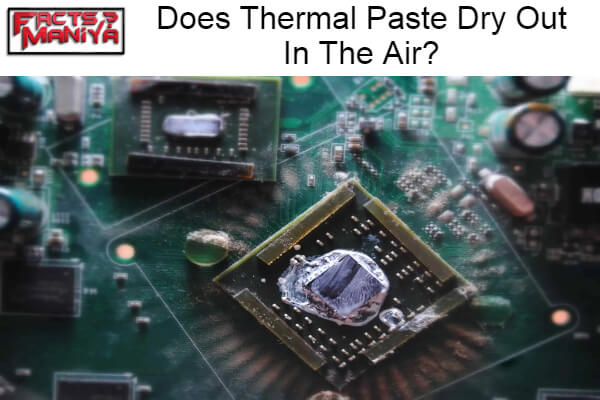If you are looking for information about whether thermal paste dries out or not, you have come to the right spot. I make computers, and I’ve built many of them over the past few years. In this article, I’ll address your question: Does Thermal Paste Dry Out In The Air? Or Is Thermal Paste Dryable, then?
Does Thermal Paste Dry Out In The Air?
Yes! Thermal paste can dry out, although it usually takes at least two to three years. If the paste is produced from common ingredients, it could sometimes take longer to dry out.

Typically, thermal paste is a paste-like material made of a chemical compound that is thermally conductive. It has a pretty long lifespan. If the paste is adequately preserved, it won’t dry out for an excessively long time.
You still have many questions about this subject, and all of them are answered below. Therefore, read this essay through to the finish.
How Much Time Does Thermal Paste Need To Dry Out?
It will take a while for the thermal paste to dry if it is applied properly within the CPU and heatsink. When does thermal paste typically dry? Depending on the components used to make the paste. If the paste is manufactured from top-notch materials, it won’t dry out for years.
However, if the thermal paste is of poor quality, it will dry out in two to three years. Many experts advise updating the thermal paste every two to three years because the standard thermal paste included with PCs and laptops is not very good.
Overall, it must be acknowledged that a thermal paste typically takes 2 to 3 years to dry up completely. Therefore, replacing the paste within that time window is a smart idea.
Does Thermal Paste Dry Out In Air?
Most PC builders do not advise using this thermal paste even though, in general, it does not dry up in the air and is a paste-like substance that is not exposed to the air.
The seal between your processor and heat sink is made of thermal paste. When you pulled it apart, the air was introduced into the previously thermal paste-only airtight seal. There is a possibility that air bubbles will be caught between the thermal paste and the heatsink when you reinstall the heatsink without applying fresh thermal paste.
However, as long as you are at a safe temperature, this won’t hurt you, though you might feel a slight temperature increase.
Should I Wait After Using Thermal Paste?
A simple no is a response. Since the thermal paste is a paste-like substance, it never dries. It must have a pasty shape to fill the spaces between the processor and the heatsink. It’s often acceptable to utilize it immediately away.
If you like, you can wait for it to “set” for two or three hours before using your computer again. The only issue with this is that it might still lead to overheating issues if you didn’t use enough paste or if the paste wasn’t placed properly, so it is covered evenly.
Is Dry Thermal Paste Bad?
Dried thermal paste is indeed horrible; it’s worse than using none at all. Because dry thermal paste can raise your CPU’s temperature and produce excessive heat, which can further harm your CPU, motherboards, and other PC components, experts do not advise using it at all.
If you discover that your thermal paste has dried out and you don’t have any additional, you will need to clean the old thermal paste, and toothpaste will work. It will be fine to use toothpaste in place of the dried thermal paste for a day or two, even though toothpaste also dries up quickly.
What Causes Thermal Paste To Dry?
Although there are no serious problems that could cause your thermal paste to dry out immediately, some factors could cause it to dry out gradually. The age of the thermal paste is the first factor that causes it to dry.
The effectiveness of thermal paste deteriorates over time. Your old thermal paste needs to be replaced every two to three years. Second, there is a potential that your paste will dry quickly if you frequently open your motherboard and leave it open since it maintains contact with air bubbles.
Dried Thermal Paste Symptoms
Many individuals are unsure about the signs and symptoms of dried thermal paste; I have described them below.
Typically, there are only two ways to determine whether the thermal paste has dried out. Disassembling the CPU cooler and heatsink is the first step in conducting this investigation. Due to the complexity of this procedure, many novice PC builders find themselves unable to check in this way.
So choosing the second approach is always the best choice. You will notice the signs of an excessive temperature rise in the processor and the machine shutting down or throttling down in performance if your CPU is two to three years old.
Additionally, you will frequently find that your CPU temperature rises above 70 degrees Celsius while working on routine chores. If you are experiencing these problems, your thermal paste may be old or dried out, and you need to change it immediately to avoid damaging your computer’s components.
Can You Use Dried-Up Thermal Paste?
No! It is never advised to use dry thermal paste; in fact, dried thermal paste is worse than using none at all. Thermal paste is a paste-like substance found inside the CPU cooler and heatsinks. It keeps the system’s components cool by dissipating the heat generated by the CPU.
The thermal paste will lose its effectiveness and be unable to transfer heat from the components if it dries up. As a result, your systems’ internal components will experience extreme heat, eventually damaging them. Therefore, experts advise against using dried thermal paste and instead advise replenishing it periodically.
How To Clean Dry Thermal Paste?
To remove the dried thermal paste from your system, you primarily need two items: a cotton cloth and isopropyl alcohol. Disassemble the CPU cooler from the CPU to remove the paste after placing both items in place.
Use the cotton cloth dipped in isopropyl alcohol to gently wipe the dried thermal paste. You can alternatively choose to apply a small amount of thermal paste to the CPU’s center and then remove it with a dry cotton wipe. You should take care not to leave any fibers on the CPU after removing the previous thermal paste.
To Conclude
Given all the information about Does Thermal Paste Dry Out In The Air? It is necessary to state that it doesn’t dry out overnight; instead, it takes two to three years. But replacing the thermal paste regularly is a healthy practice.
I hope you found this post useful, and if you’re interested in learning more about thermal paste, PC Components, and other tech-related topics, be sure to check back here frequently.

